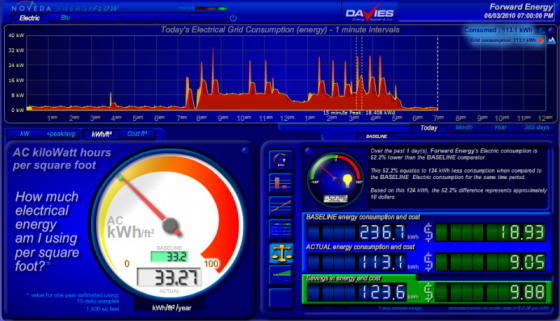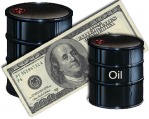
One of the most cost-effective ways to reduce energy costs is to monitor energy consumption in one minute increments and watch the trends over time. Almost every building will immediately find quick and easy ways to reduce energy costs by 5% or more. And knowledgeable professionals can often use the data to drive down energy costs by 20% or more and improve facility comfort and performance at the same time.
Let's take an actual example. Forward Energy Solutions recently subscribed to Continuous Energy Management & Optimization (CEMO) from Davies Energy Systems. The process involved two steps: (1) installing a real-time energy monitoring system from Noveda Technologies; and (2) having Davies Energy's engineers analyze the data and develop better ways to manage and optimize facility energy usage.
Here is the minute-by-minute display of electricity consumption that Forward Energy Solutions saw after just one day:
Let's take an actual example. Forward Energy Solutions recently subscribed to Continuous Energy Management & Optimization (CEMO) from Davies Energy Systems. The process involved two steps: (1) installing a real-time energy monitoring system from Noveda Technologies; and (2) having Davies Energy's engineers analyze the data and develop better ways to manage and optimize facility energy usage.
Here is the minute-by-minute display of electricity consumption that Forward Energy Solutions saw after just one day:
Notice the two distinct sets of spikes in energy consumption. The first occurred just before 4:00 a.m. when no one was in the building. The next set of distinct spikes started at 7:00 a.m. and continued until 5:00 p.m. Each of the spikes lasted only a minute or less and were not noticed by the people in the building. But over time they amounted to a significant increase in kwh consumption. They also may increase the peak demand charges on the company's monthly electric bill.
The culprits were quickly identified. A small refrigerator was malfunctioning and spiking the consumption at 4 a.m. An air-conditioning system in need of repair was causing the spikes during regular business hours.
Catching these types of problems generates immediate savings by reducing kwh consumption and peak demand charges. The avoided costs will continue to be realized each and every month into the future, often adding up to thousands of dollars in energy savings.
Identifying these types of problems early on also avoids the cost of more expensive repairs down the line. Without monitoring, no one would have noticed the air-conditioning problem until it stopped cooling the building -- most likely on the hottest day of the year. At that point, the company would have already wasted money on unnecessary energy costs, plus it would be facing the higher cost of repairing or replacing the air-conditioning system on an emergency basis. Not to mention the loss of employee productivity in a sweltering office until the repairs could be made.
Francis X. Lamparello, P.E., the Chief Technology Officer at Davies Energy Systems, says that he finds these types of issues in almost every building. But these problems are just the tip of the iceberg when it comes to saving energy. "Buildings are living, breathing entities that must be monitored and adjusted on a continuous basis," he says. "For example, maintaining proper air pressure inside the building can keep warm air from entering in the summer, and letting in more cool outside air on a sunny Fall day can give you 'free cooling' to offset the heat caused by the sun shining on the windows." All of these energy saving solutions, he points out, are free or inexpensive once you have real-time monitoring and expert advice on how to manage the facility.
What's next for Forward Energy Solutions? Now that they have the data, they are working with Davies Energy on a number of additional ways to drive down their energy costs. More on that in later blog posts.
John Howley
Orlando, Florida
The culprits were quickly identified. A small refrigerator was malfunctioning and spiking the consumption at 4 a.m. An air-conditioning system in need of repair was causing the spikes during regular business hours.
Catching these types of problems generates immediate savings by reducing kwh consumption and peak demand charges. The avoided costs will continue to be realized each and every month into the future, often adding up to thousands of dollars in energy savings.
Identifying these types of problems early on also avoids the cost of more expensive repairs down the line. Without monitoring, no one would have noticed the air-conditioning problem until it stopped cooling the building -- most likely on the hottest day of the year. At that point, the company would have already wasted money on unnecessary energy costs, plus it would be facing the higher cost of repairing or replacing the air-conditioning system on an emergency basis. Not to mention the loss of employee productivity in a sweltering office until the repairs could be made.
Francis X. Lamparello, P.E., the Chief Technology Officer at Davies Energy Systems, says that he finds these types of issues in almost every building. But these problems are just the tip of the iceberg when it comes to saving energy. "Buildings are living, breathing entities that must be monitored and adjusted on a continuous basis," he says. "For example, maintaining proper air pressure inside the building can keep warm air from entering in the summer, and letting in more cool outside air on a sunny Fall day can give you 'free cooling' to offset the heat caused by the sun shining on the windows." All of these energy saving solutions, he points out, are free or inexpensive once you have real-time monitoring and expert advice on how to manage the facility.
What's next for Forward Energy Solutions? Now that they have the data, they are working with Davies Energy on a number of additional ways to drive down their energy costs. More on that in later blog posts.
John Howley
Orlando, Florida



 RSS Feed
RSS Feed